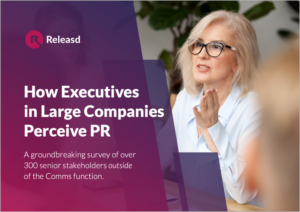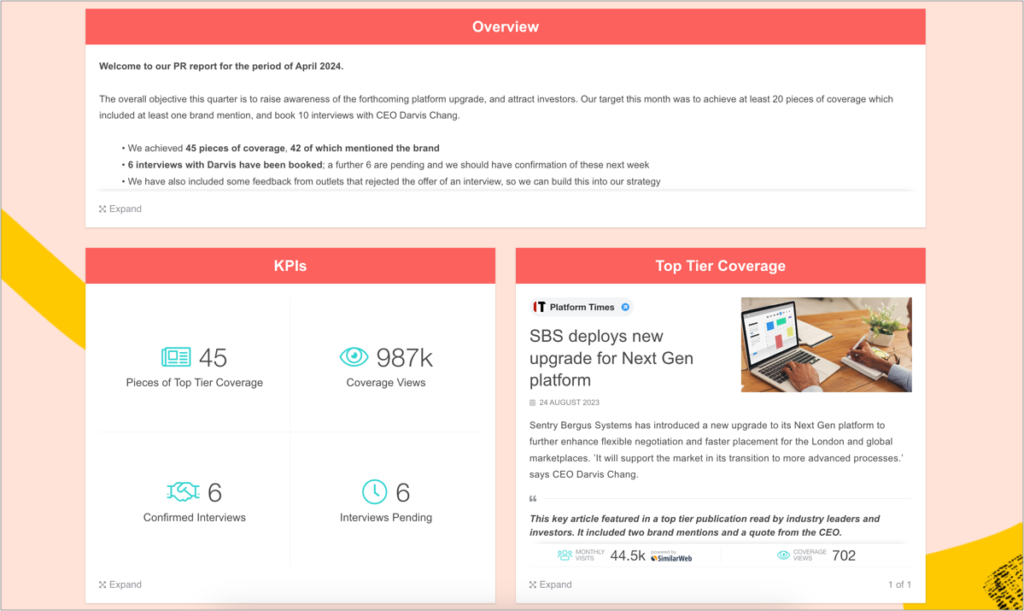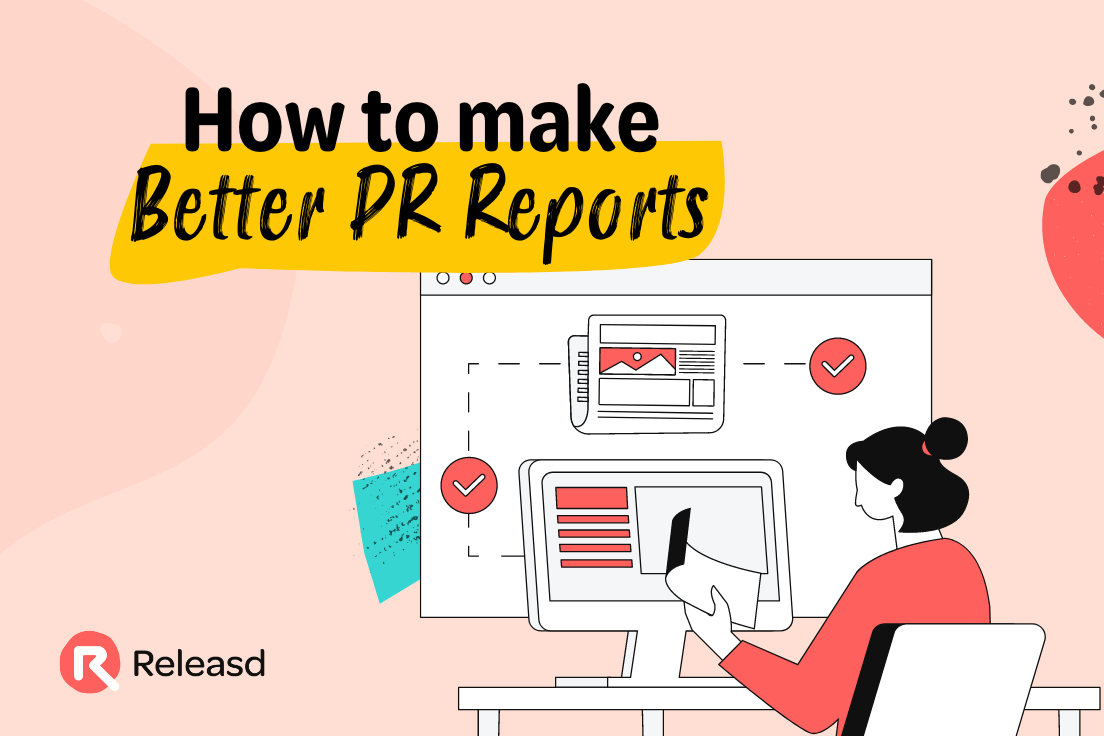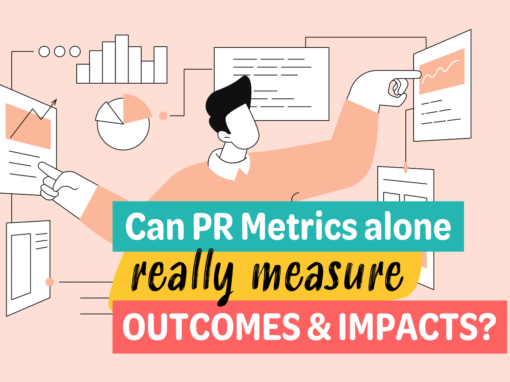
Richard Benson | MD, Releasd
PR reporting is about accountability – but it also presents an opportunity to celebrate success and strengthen relationships. Good reporting is nimble and strategic. It can secure clients, win bigger budgets, build pride and generally increase the reputation of Communications as a whole.
Releasd has been going for nearly a decade, and in that time our users have created hundreds of thousands of PR reports. We have truly seen it all and wanted to share some key learnings and best practices picked up over the years.
Here are the key factors that we’ll explore in this article:
🤝🏽 1. Collaboration: Engaging with recipients to tailor reports to specific needs and objectives. This ensures that effort in reporting aligns with what stakeholders find valuable.
🎓 2. Providing Context: Ensuring that the report can be understood by executives who might not be familiar with PR or its role in the company. Clear, concise introductions and explanations enhance the report’s value.
🔭 3. Beyond Coverage: Expand reports to include a narrative of the work done, such as strategy and background activities, not just media coverage.
🌡️ 4. Narrative Metrics: Use metrics not only to present data but to tell a story of progress, trends, and insights.
✨ 5. Visuals: Utilise the visual aspect of PR to make reports engaging and easy to digest.
📁 6. Centralisation: Consolidate reporting into one format or document to increase the likelihood that the report is reviewed and appreciated.
According to Helen Ellis, Head of VIVID, TEAM LEWIS‘ Corporate Reputation, Sustainability and Purpose Practice:

“It’s easy to lose sight of overarching programme goals, particularly when it comes to weekly or monthly reporting. It’s important to ensure teams understand that reports shouldn’t just be viewed as a mechanism to convey what’s been achieved. They are also a forward planning tool.
She continues:
Reports that include recommendations to change, optimise or introduce elements in any programme will be of much greater value to clients. Transforming them from an admin task to a strategic asset.”
Wherever possible, the following recommendations are platform agnostic: they should be applicable whether you’re using PowerPoint, PDF, Word, Releasd or any other reporting medium to share your results.
Right, let’s dive in to our six tips for PRs looking to create more impactful reports.
Six Ingredients of Successful PR Reports
🤝🏽 1. Collaborate with recipients
Most PRs have a set way of reporting. It makes sense – it’s easier to use an existing template that has worked before. However, every client and campaign is different.
Good reports take some time and thought to compile. It’s therefore crucial to collaborate with colleagues and recipients upfront, and on an ongoing basis, in order to ensure all of that effort is wisely invested.
Rachel Ayotte is CEO of bread & Butter, a full-service digital marketing, public relations, social media and creative agency.

“When we begin any campaign, our first conversation with clients is always about their specific goals, who they’re targeting and what success looks like. While some clients are clear on KPIs and how they want success measured, we are finding more often that success depends on a number of variables that often shift weekly or monthly based on results.”
Here are some questions to ask before the first draft is prepared, and review as the relationship progresses.
What are the objectives and KPIs?
This is the obvious one: it’s essential to understand the overarching aims and key results in order to report effectively.
Deep dive or overview?
Does the recipient want a warts and all, detailed report, or a summary of the key points?
Quantitative, qualitative or mixture?
Do they prefer data in the form of charts and graphs, do they respond better to copy, or is a healthy mixture of both the best bet?
Weekly, monthly, quarterly?
What is the ideal cadence of reporting, and why?
What’s the journey?
Who will see the reports and how can we make it easy for them to get the information they need? More of this, next.
🎓 2. Provide context
A truly successful report should travel beyond the PR function and be seen by stakeholders across an organisation, regardless of its size.
However, according to our own research, almost two in ten executives either do not know what PR stands for, or think it stands for something incorrect.

A little bit of context goes a long way.
It can be as simple as adding a clear, concise introduction, explaining why certain pieces of coverage are important, or sharing broader objectives and KPIs.

🔭 3. Expand beyond coverage
Traditional coverage reports can actually do more harm than good.
Focusing too heavily on outputs risks uncomfortable questions being asked: “Why is there less coverage than last month?” or “What are you doing for the money we’re spending?”
That’s because the reader is being asked to gauge value based purely on volume. Volume of coverage is usually outside of the control of the PR professional, and can fluctuate wildly, so this presents risk.
We all know that there’s more to Comms than coverage. Modern PR agencies and in-house teams offer a wide variety of invaluable services, of which media relations is but one.

Rachel Ayotte | CEO, bread & Butter
“Even with clients we’d worked with for years, we’d still see that they didn’t really understand or realize the amount of work we’re actually doing.
Sound familiar? Rachel continues:
When building reports for annual or even short-term campaigns, we’ve found it invaluable to be able to add color beyond just press secured. From highlighting the work that went into writing a press release, the strategy behind our communications plans or even our creative team’s work such as crafting a custom invitation or email newsletter, we’re able to showcase a more robust campaign that goes beyond just numbers and metrics.”
Truly impactful PR reports make it clear that there is valuable work being done, regardless of the amount of coverage achieved.
🌡️ 4. Use PR metrics to tell a story
Most PR reporting platforms include a range of metrics. Reach and Domain Authority come as standard. Some also provide Coverage Views, Social Engagement and more. The temptation is to display the numbers and move on. However, a little attention in this area can provide a lot of value all round.
One example of this is benchmarking: by keeping track of historic results, PRs can demonstrate meaningful progress and uncover what’s driving it. Conversely, downward trends can be spotted and the underlying issues addressed.
For example, let’s say the total Coverage Views for a campaign this year is 500k. Is that good? It’s hard to tell. But if we know it was 250k last year, we can then investigate what changed and include that as a key learning. Much better.
✨ 5. Leverage the visual aspect of PR
Sometimes, PR really needs to do a better job of PRing itself.
Hands up if you’ve ever shed blood, sweat and tears to achieve a fantastic piece of coverage…and all the client sees is a plain old link.
Or event has taken place – there’s lots of gorgeous photography and even a sizzle video. But execs across a business have no idea it happened.
Clients and execs are time poor. They’re also human (for now). Comms reports are competing with those from other functions.

Rachel Ayotte | CEO, bread & Butter
“We love being able to share photography, creative elements and metrics in a way that is easy to read and visually appealing. Clients like it too.”
A good PR report should therefore exploit the visual nature of the medium and capture the reader’s attention immediately.
📁 6. Showcase everything in one place
We speak to PR teams using a variety of formats to share their results: Excel Google Sheets, Word, Slides, PPT, PDF to name a few. We often learn that they’re sending a mish-mash of information to their stakeholders. That’s clearly a problem.
A busy client faced with an email bursting with copy and links, a spreadsheet to review and separate presentation to flick through is likely to think “I’ll check that out later.” This is the danger zone for PRs. Work has been done, results have been delivered, but they’ve gone unappreciated by the budget holder.
Instead, we recommend creating a single report that includes everything in an easy to digest format. One link, one attachment, one email – whatever the medium, this significantly increases the likelihood that the contents will be absorbed.
Better PR Reporting is Achievable for Everyone
PR reporting has traditionally been seen as a necessary evil, but with a few easy steps, it can become a source of pride and prosperity.
Inviting early feedback from the target audience is a solid first step to ensure everyone’s on the same page. Providing a little context helps to guide readers through information being presented. Sharing the full breadth of work done mitigates risk by demonstrating that there’s more to PR than the volume of coverage generated. Benchmarking metrics helps to tell the story behind the results, whilst focusing on visual impact within a single format increases the likelihood that the work will be fully absorbed.
None of this costs money – but it could very well help retain a key client or increase next year’s budget.



